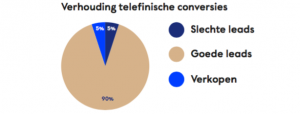Wil je weten wat call tracking kan betekenen voor jouw organisatie? Neem contact met ons op.
Conversion ratio in Google Ads tripled thanks to call tracking
 4 MIN READING
4 MIN READING
Conversion ratio in Google Ads tripled thanks to call tracking
THE ORGANISATION
For more than twenty-five years, the organisation in this case has focused on supplying many types of glass and carrying out glass repairs throughout the Netherlands. The organisation has more than fifty distribution locations and a repair service that can be on site in under thirty minutes in case of an emergency.
“Being easy to find is the key to success in the repair sector.”
If you are dealing with broken glass, you want to act quickly. It is therefore essential that the organisation is easy to find. The company understands this and has therefore opted for a location-based approach and comprehensive use of online media. The organisation has a town-based content strategy and is therefore easy to find – both organically and via paid media. For this organisation, the best-converting and most important online marketing channel is Google Ads.
In the event of glass damage, consumers typically use the phone to call for help. The high costs of online advertisements and the incomplete insight into the realised performances led the organisation to look for a way to make phone call leads insightful down to the keyword level and evaluate the quality of these leads. The company ultimately chose AdCalls Call Tracking.
CHALLENGE
The high costs of advertising via Google Ads were the company’s main reason to want more insight into the effects of phone call leads. Furthermore, the following issues were also factors:
- To what extent do phone call leads contribute to the total number of valuable interactions?
- What keywords generated phone call leads and how does this affect the conversion ratio?
- How valuable are phone call leads?
SOLUTION
Local nature
The organisation uses call tracking to make the phone call leads generated by its use of Google Ads insightful. They opted to issue a unique telephone number per region and per new visitor that matches the area code of the region in question. Visitors from Amsterdam, for example, will see a 020 number, while visitors from Eindhoven see a number that starts with 040. All this contributes to the local nature that the organisation wants to set itself apart with.
Evaluating calls
Furthermore, the company makes active use of the option to evaluate calls. This is done using the evaluation menu that is played after every call. When evaluating calls, a distinction is made between the following elements:
- Sale
- Lead
- Other
Sales are evaluated based on the order value that was realised and leads are rated on a scale from one to five. It was decided to only process leads with a score of four or five as conversion in the Google Ads campaign.
Conversion optimisation at the keyword level and call evaluation
For every call that is realised with call tracking, an ‘event’ is sent to Google Analytics. These ‘events’ are recorded as goal measurements in the Google Analytics account in question. This lets the organisation know how many call conversions were realised per keyword.
The event contains the following information:
- The keyword that was used
- The match type
- The call evaluation
Every evaluation has its own goal measurement in Google Analytics. It was decided to only import the valuable goal measurements in Google Ads. This ensures that any optimisations are only based on the valuable keywords.
RESULT
Between January and December of 2015, the use of call tracking has resulted in the following insights:
Ratio of online and call conversions
The statistics confirm the belief that the majority of leads are realised via the telephone.
- 63% of the conversions is a call

The conversion ratio has tripled and the costs per conversion have gone down
By measuring calls, the conversion ratio of the Google Ads campaign increased by a whopping 300%. The average costs per conversion dropped by 63%. On average, the costs per conversion of call conversions are 40% lower than those of online conversions.
Using call tracking gives the organisation a complete overview of all interactions – i.e. both online and call conversions – that generate valuable leads and sales. If the company were to decide to exclude all keywords that do not generate any conversions from the campaign, it can realise a maximum cost reduction of 37.4%.
Insight into more keywords
It is clear that the majority of visitors contact the organisation by phone. However, do these visitors use other keywords as well? Our research shows that the use of call tracking has resulted in an 18% increase of the number of conversion-rich keywords. Not a single online conversion had ever been realised with these keywords, despite the fact that they do generate relevant calls.
As expected, keyword themes concerning ‘emergency’ and ‘direct contact’ result in a very high number of calls, which turned out to be exceptionally valuable to the client.
90% of the calls translate to qualitative leads
By actively evaluating calls, the company acquired much better insight into the calls that immediately converted into a sale. It turned out that circa 90% of the calls translated to qualitative leads.

Call tracking provides:
- A complete overview of all calls via Google Ads
- The opportunity to actively evaluate calls
- A 300% increase of the conversion ratio
- A 63% reduction of the average costs per conversion
- 18% new relevant keywords
- Insight into the quality of calls





